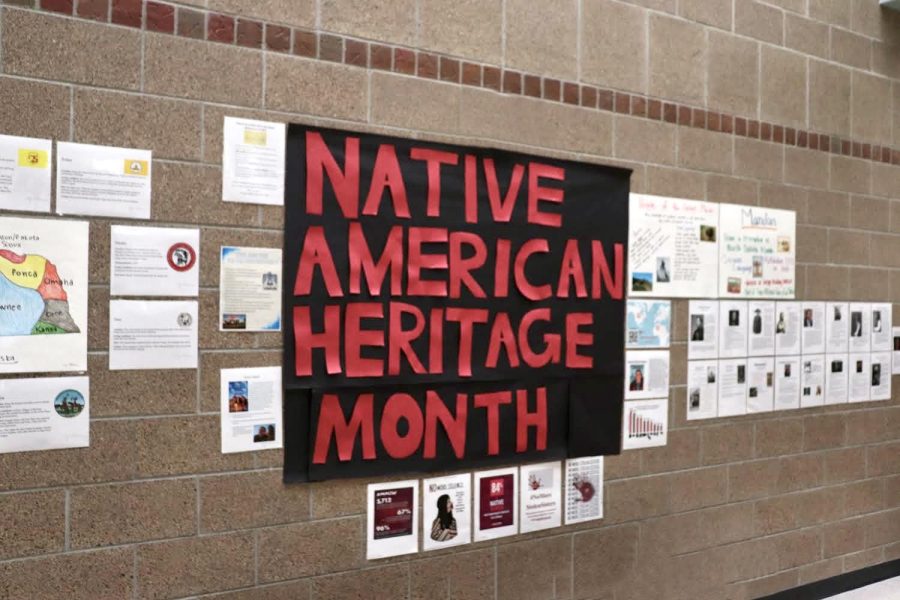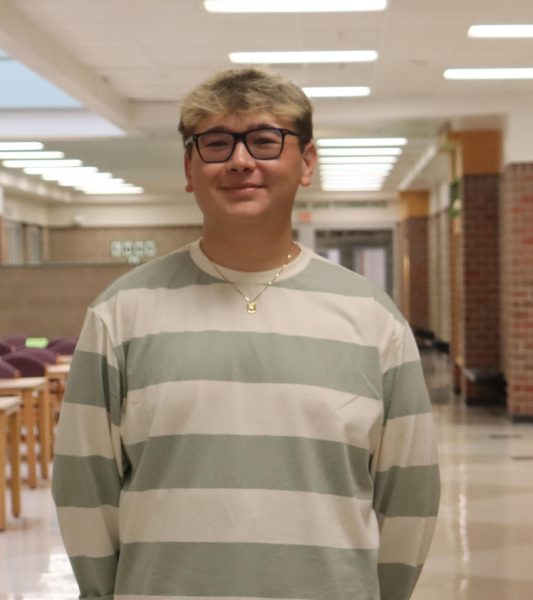Native American Heritage Month: spreading awareness for missing and murdered indigenous women
Justice and Diversity League members commemorate an unserved population
Photo courtesy of Quinn Burton
Showcased in Millard West’s main hallway posters and informative displays were viewed by students and faculty to gain knowledge about the injustices experienced by Native American cultures. After spending weeks preparing the display, Justice and Diversity League students were prepared to shine these injustices into the spotlight. “Our goal with the display was to engage people in something as small as a story or journey of a Native American leader,” Justice and Diversity League sponsor Bryant Bull said. “Perhaps if just one student reads something about a Native American figure on that wall, it will spark their curiosity. It is not intended to be a thorough look into Native American culture because there are hundreds of them, but if we show you a little bit during this month it promotes a sense of inclusion and acknowledgment among students and faculty.”
November 18, 2021
With Nov. 1 marking the start of Native American Heritage Month, schools throughout the nation are acknowledging the injustices experienced by Native American cultures. At Millard West, students from Justice and Diversity helped create a display to raise awareness for this underrepresented group of individuals.
The process of creating the display involved a lot of research and creativity. Students spent weeks researching and compiling evidence relating to Native American history. Students acknowledged Native American Heritage Month as a time set aside for appreciating the cultures and achievements of Native Americans. Features such as traditional music and dances, legends and stories, and historical figures were all included to show how this heritage month came to be. It is an important time for building public knowledge and respect for Native people, as well as educating the public about the challenges they have experienced.
The informative displays showcased several aspects of Nebraska’s Native American cultures, as well as the current population within the state. This helped students gain knowledge about the vast population of Native American tribes that have existed in Nebraska for thousands of years. Today, six tribes — the Omaha, Winnebago, Ponca, Iowa, Santee Sioux, Sac and Fox — have reservations throughout the state, accounting for approximately 1% of Nebraska’s total population. Members of the Justice and Diversity League utilized this information to demonstrate that, while they may not realize it, this issue has a direct impact on students in the Omaha area.
“It’s important to learn about other cultures and especially Native culture because all that has been perpetrated against them and considering they are Native to the country we live in,” Justice and Diversity League member and senior Abigail Rogers said. “I am a firm believer in helping others and speaking out against injustice, especially those disadvantaged and tied down unfortunately by many obstacles my ancestors are the cause of, which is why everyone should be educated about Native cultures and different ethnicities.”
The display gave a diverse group of students the chance to get creative and hands-on while also sharing important information. Students researched important Native American figures online, which they would include in their informational signs and posters.
“On the wall, we displayed influential leaders from Native American history and events,” Justice and Diversity League sponsor Bryant Bull said. “We try to educate kids on the tribes that operate here in Nebraska. It’s important because Native Americans are often treated as an unrecognized aspect of history, but we want to teach students that it’s actually woven into the fabric of the country.”
To further bring acknowledgment for these individuals, the Justice and Diversity League will commemorate Red Shawl day on Nov. 19, which is a day of remembering and honoring missing and murdered Native American women and Alaska Natives. On this day, students will paint red handprints on face masks in solidarity with the missing and murdered indigenous women.
“The amount of missing Native American cases is something that isn’t talked about and is always swept under the rug,” senior Alexis Bahensky said. “We decided that we should showcase this injustice and recognize that this is something that has happened throughout history and is still happening today. Currently, this is the only day where we are able to recognize these missing and murdered indigenous women, but maybe if we expand this over the entire month more cases will be solved and awareness will be gained.”
The display is currently hanging in front of the library, where students and faculty can view it. The Justice and Diversity League will keep the display up for the entirety of the month in hopes that people will be interested in learning more about Native Americans’ history and cultural significance. For the time being, the display will deliver an important message of inclusivity at Millard West.







